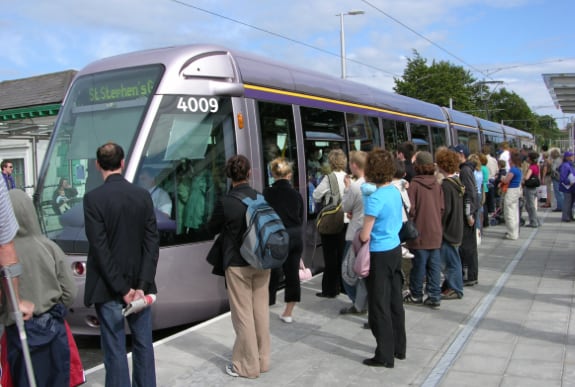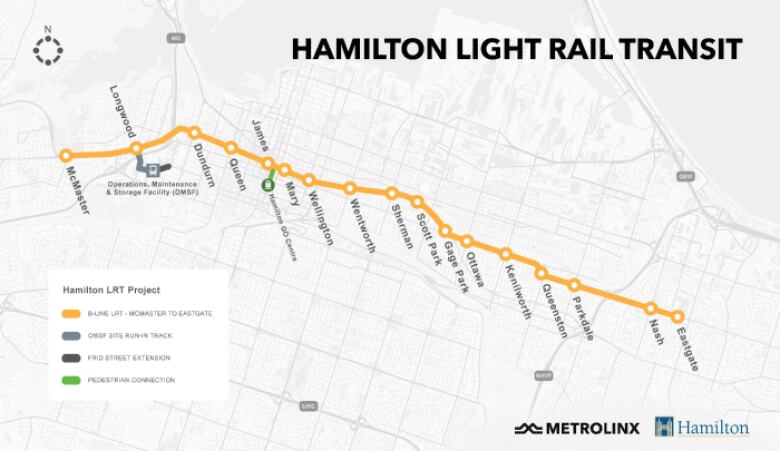LiUNA-backed review puts Hamilton LRT cost at $3.5B, offers funding options
Union VP suggests provincial, federal, private investment trio to get LRT done

A labourers' union that supported Hamilton light-rail transit (LRT) has completed its own commissioned study into how much the project would cost, and saysgovernment assistance plus private investment from branches like its own pension plan would get it done.
And theLaborers' International Union of North America (LiUNA) says it would welcomebeing a part of the project.
The Union says its confidential review, completed by FengateCapital, shows the project would be worth$3.4 billion to $3.6 billion.
International vice president Joseph Mancinelli said it was "frustrating and aggravating" to see the numbers, given the province gave a $5.6 billion price tag during its chaotic cancellation.
But the difference, he said, was because the province was using numbers "padded with all sorts of expenses" that didn't have to do with its construction, like operating costs that inflated and "distorted" the picture.
President of Fengate Capital, Lou Serafini said $3.5 billion accounts for the total costs of constructing, mobilizing, (e.g. preparing for construction), and financing, if the LRT were built today.The range, he said, shows how variables, like financing costs, can change the overall total.
The union decided to crunch its own numbers following provincial numbers shared by Minister of Transportation Caroline Mulroney that showed capital costs of$2.8 billion and included operating and maintenance costs over 30 years for a total of $5,554,681,932.
A heavily redacted version of the report previously obtained by the NDP and CBC News through separate Freedom of Information Actrequestsonly shows $2.32 billion in capital costs, which includes escalation and contingency, and $818.8 million in operating, maintenance and life cycle costs.
Serafini said Fengate didn't have access to ongoing numbers for the report, such as future maintenance costs or subsidies required for transit. The final cost, he said, would be determined on the final scope of work. And any changes, like fewer stations, would bring this cost down.
He said it also didn't address what you would need to reserve for repairs or replacements depending on how long the contract was.

The review, first reported by The Hamilton Spectator, proposes the project could get done with a subsidies of$1.2 billion from each the provincial government and federal government, and finished withinvestment from the private sector.
In 2015, the former provincial Liberal government said Metrolinx would spendup to $1 billion on capital costs to build LRT.
Mancinellimaintained that the three party approach could work, with pension plans like LiUNA's which has eight hospitals under its belt that are looking for long-term investments helping to make upthe rest.
Last month, Infrastructure Minister Catherine McKenna pointed to public transit investments as key to helping cities rise from their COVID-19 economic slumps. And the only "shovel ready" transit proposal in Hamilton, she said, is LRT.
Before that in mid-April, atask force set up by province (and which included LiUNA)with the goal of figuring out how to spend $1 billion earmarked for Hamilton LRTbefore the government pulled the plug decided it should still spend the money on LRT or bus rapid transit.
Mancinelli said he's been in talks as recent as this week withMcKenna and echoed her reference to the COVID-19 pandemic.
"What better way to energize the economy than to have large transportation infrastructure projects like this LRT in order to get people working and get money circulating in communities and get the economy back in shape," he said.

He said LiUNA also continues to speak with Mulroney and Premier Doug Ford,who has attended LiUNA events in the past and who the union supported in the 2018 election.
LiUNA represents around 130,000 construction workers, andto accusations that the union is lobbying for the LRT because they "want the jobs" Mancinelli says, "but of course."
Part of the analysis, which shows different options on how to afford the LRT, involves private investors looking at$250 million of land development along the 14-kilometrecorridor, including rights to the "air space" above stations or along the route tobuild properties.
"We are probably not only full speed ahead [of the governments], but way ahead of them," he said. "We are definitely pushing hard."
It also lists different ideas for paying for LRT, like aCanada Infrastructure Bank loan. and whether investors would get a share of the fares, thoughMancinelliadmits it would be unlikely not to go to the city.












_(720p).jpg)


 OFFICIAL HD MUSIC VIDEO.jpg)
.jpg)



























































































